With over 100 species forming a part of this subfamily of plants, the Emu bush is a stand out thanks to its silvery-green tapered foliage that shoulders soft, tubular radiant red to orange flowers.
These delicate flaring flowers are cherished by nectar-loving birds, bees, and butterflies so this plant is great for those interested in adding a touch of wild lusciousness to their gardens.
We are very passionate about our Australian natives so let’s take a deeper look into what makes Eremophila so special and how you can grow, care, and use this evergreen in your garden.
More...

Family: | Scrophulariaceae |
|---|---|
Genus: | Eremophila |
Common Names: | Emu Bush, Tar Bush |
Location: | Outdoors |
Type: | Shrub |
Growth: | 0.3 to 3m tall, 1 to 3m wide |
Sun requirements: | Full Sun |
Foliage Colour: | Silver Green |
Flower Colour: | Orange, Red, Yellow |
Flowering: | Winter to Spring |
Maintenance level: | Low |
Poisonous for pets: | Non-toxic to cats and dogs |
Introducing Eremophila
Emu bush or Eremophila is endemic to Australia and forms a part of the Scrophulariaceae family. Commonly referred to as Tar Bush, this plant grows natively in the inland arid parts of Australia where it thrives in a mostly dry climate.
Growers have however also had success cultivating emu bush in more temperate climates. There are a couple of popular garden plant varieties that form a part of the Eremophila genus ranging from small prostrate shrubs to taller upright shrubs. Emu bush itself can be low-growing or sometimes grow in a more upright fashion.
Eremophila is a medium shrub identifiable by its grey-green open foliage and red, orange or sometimes yellowish tubular flowers that bloom between autumn and spring. This fast-growing shrub has a habit of spreading and is very water-wise.
Commonly used as a feature plant for drier gardens, emu bush can also be potted for use as an ornamental accent in outdoor spaces. Low-growing varieties are often used as a native ground cover that can suppress weeds and help stabilise the soil.
Popular Types of Eremophila
Tar Bush (Eremophila glabra)Known as tar bush, this medium variety of shrub is the most accessible and features red, orange, or yellow tubular flowers with grey to green lance-shaped leaves that taper gradually towards the stem. | 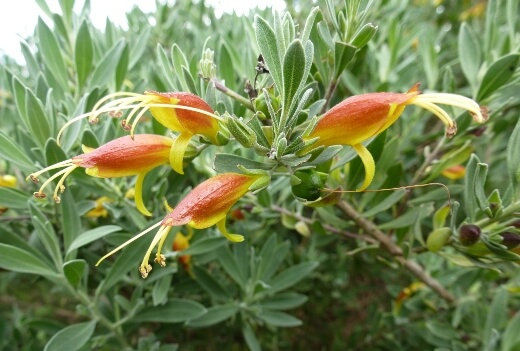 Source: en.wikipedia.org |
Silky Eremophila (Eremophila nivea)Known as Eremophila nivea, this smaller variety of shrub is a flowering plant that is declared rare in nature. It has hairy branches and silver leaves with blue, purple or violet flowers. |  |
Prostrate Eremophila (Eremophila biserrata)Known as prostrate eremophila, this shrub is a low-growing variety that has snake-like stems with serrated leaves and flowers that bloom in green and yellow. | 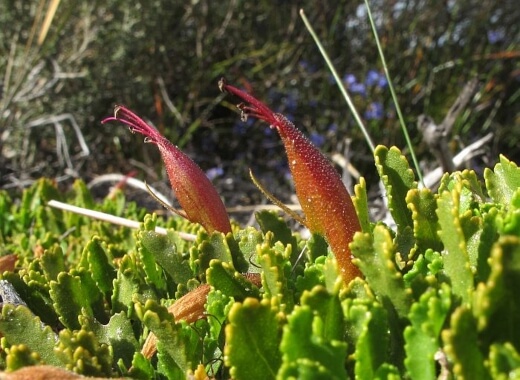 Source: esperancewildflowers.blogspot.com |
Pink Beauty (Eremophila laanii)Known as ‘Pink Beauty’, this variety is taller and grows more like an upright shrub or small tree with long tangling branches and purple to pink flowers. | 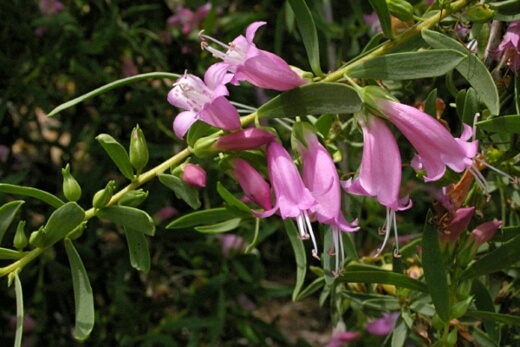 Source: anpsa.org.au |
Tar Bush (Eremophila glabra)

Source: en.wikipedia.org
Known as tar bush, this medium variety of shrub is the most accessible and features red, orange, or yellow tubular flowers with grey to green lance-shaped leaves that taper gradually towards the stem.
Silky Eremophila (Eremophila nivea)

Known as Eremophila nivea, this smaller variety of shrub is a flowering plant that is declared rare in nature. It has hairy branches and leaves with blue, purple or violet flowers.
Prostrate Eremophila (Eremophila biserrata)

Source: esperancewildflowers.blogspot.com
Known as prostrate eremophila, this shrub is a low-growing variety that has snake-like stems with serrated leaves and flowers that bloom in green and yellow.
Pink Beauty (Eremophila laanii)

Source: anpsa.org.au
Known as ‘Pink Beauty’, this variety is taller and grows more like an upright shrub or small tree with long tangling branches and purple to pink flowers.


Get Your Free Guide:
Master Growing Australian Natives eBook
A Must Have Complete Guide for Every Australian Garden
Get Your Free Guide:
Master Growing Australian Natives eBook
A Must Have Complete Guide for Every Australian Garden
Luckily, these varieties all share the same needs when it comes to growing conditions and care so this guide can be applied to any one of them.
Here are more types worth mentioning:
- Eremophila maculata ‘Winter Gold’ – Flowers are prolific and in bud, they open to a paler cream colour with red spots. Rounded shrub about 1 -2 metres
- Eremophila glabra 'Kalbarri Carpet' – ground cover with grey foliage and yellow flowers.
- Eremophila maculata ‘Thundercloud’ – purple flowers with purple spots, rounded shrub up to 2 metres.
- Eremophila oppositifolia – Purple Flowers in winter with long narrow smokey green foliage, a large shrub whose size can be controlled by pruning.
- Eremophila racemosa – yellow and orange flower buds, shrub up to 2 metres.
- Eremophila hillii – bright red flowers with smokey grey, green foliage, spreading shrub up to about 1.5 metres.
- Eremophila maculata Red Form – with red spots on a cream background, rounded shrub up to 2 metres.
- Eremophila calorhabdos – Pinky, Purple flowers. Tall narrow shrub with long erect branches. The height it eventually reaches will depend on how much you prune it.
Luckily, these varieties all share the same needs when it comes to growing conditions and care so this guide can be applied to any one of them. Here are more types worth mentioning:
- Eremophila maculata ‘Winter Gold’ – Flowers are prolific and in bud, they open to a paler cream colour with red spots. Rounded shrub about 1 -2 metres
- Eremophila glabra 'Kalbarri Carpet' – ground cover with grey foliage and yellow flowers.
- Eremophila maculata ‘Thundercloud’ – purple flowers with purple spots, rounded shrub up to 2 metres.
- Eremophila oppositifolia – Purple Flowers in winter with long narrow smokey green foliage, a large shrub whose size can be controlled by pruning.
- Eremophila racemosa – yellow and orange flower buds, shrub up to 2 metres.
- Eremophila hillii – bright red flowers with smokey grey, green foliage, spreading shrub up to about 1.5 metres.
- Eremophila maculata Red Form – with red spots on a cream background, rounded shrub up to 2 metres.
- Eremophila calorhabdos – Pinky, Purple flowers. Tall narrow shrub with long erect branches. The height it eventually reaches will depend on how much you prune it.
How to Grow Eremophila

This plant is the perfect pick for drier areas and gardens thanks to its hardy nature. Being native to arid inland areas of the country, this shrub can tolerate long dry spells and is easy to grow given the right location and environment. It is however not suited for cool climates.
Emu bush can also be successfully grown in more temperate areas where it is essential to provide the plant with good drainage and lots of sunlight. A shorter lifespan can often be expected in more temperate conditions.
Many growers prefer to seek out healthy plants from reputable native nurseries that can simply be transplanted into their gardens. However, these shrubs can also be propagated using softwood cuttings.
It is not recommended to try to propagate this plant using seeds as it is known to be an unreliable method.
Eremophila Propagation
Propagation Eremophila Using Cuttings
Members from this family can be propagated using stem cuttings from the current season’s growth. To propagate emu bush using cuttings, you can follow these simple steps:
- Using a sharp knife or sharp scissors, take cuttings of about 75 to 100mm in length from a healthy plant after the flowing season has passed.
- Carefully remove the leaves from the lower two-thirds of the stem.
- To improve your chances of success, you can “wound” the lower stem and remove a sliver of bark. Then dip the stem into some rooting hormone.
- Place the cutting into your potting mix and cover lightly with the soil.
- Water well and place the container in a warm location that gets a lot of light.
- New roots can start to develop in about 4 to 6 weeks.
Ideal Conditions for Planting Eremophila
This shrub is tough but will still grow best in conditions that allow the plant to thrive. Being a native, these plants should grow well throughout most of the country. Let’s have a look at some of the growing conditions for emu bush.

Source: anpsa.org.au/
Sunlight
Generally speaking most eremophilas also prefer to grow in full sun. In their natural environment they tend to grow in open arid areas devoid of larger trees that could provide shelter so in the home garden they will perform best in an area that gets sunshine for the majority of the day.
What Soil to Use
Firstly most eremophilas do like reasonable drainage. They don’t like to be planted in an area where water will sit for some time after rain. Therefore plant them in a well draining soil or if you have a heavier soil or one will a clay subsoil plant them on a slope or a raised garden bed.
This is something that can be overlooked as quite often eremophilas are turned to in times of drought and as a consequence can be planted in inappropriate places. Therefore they can survive quite happily for many months and even years surviving quite happily on very low rainfall right up until the drought breaks.
Then all of a sudden they find the soil they are growing in is wet and boggy and as a consequence they start to deteriorate and because most of the water may be in the subsoil it may not be apparent to the gardener and all of sudden the gardener starts scratching their head wondering what the problem is.
Therefore where you plant your eremophilas can be quite important.
Temperature & Humidity
These shrubs can grow in most climates from warm temperate to dry regions. They are known to be difficult to grow successfully in cooler climates.
How to Plant Tar Bush
Now that you’ve picked out the perfect sunny spot for your eremophila, you can prepare to plant it. These shrubs can be planted directly into your garden bed or potted for use as an outdoor pot plant.
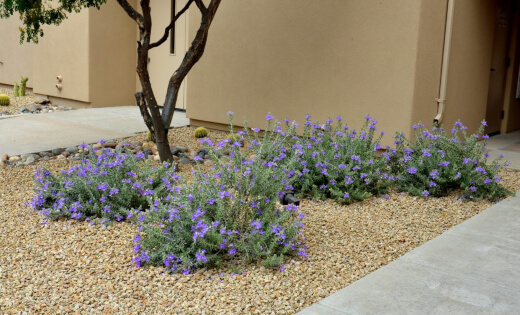
Source: wateruseitwisely.com
Planting Tar Bush in the Garden
- Pick a location in your garden that gets full sun to partial shade each day.
- Dig a planting hole that is at least twice as wide and to the same depth as the root ball of the shrub.
- Gently remove the plant from its current container then lightly tousle the roots loose with your fingers.
- Position the shrub in your planting hole where the root crown is level with the soil.
- Refill with your soil mix and gently pat the soil firm once the plant is in position.
- You can optionally create a raised ring of soil around the outer edges of the plants’ root zone to help the water stay where it is needed.
- Water the plant well after planting so that the soil will remain moist for the first few weeks. This will help the roots settle in the soil and establish themselves.
- Add organic mulch around the base of the emu bush being sure to keep it away from the trunk.
Planting Emu Bush in a Pot
- Use a container that is at least double the size of the shrub you intend on planting.
- Position the pot in a sunny position around the garden.
- Fill your container with your potting mix.
- Gently remove the plant from its current container then lightly tousle the roots loose with your fingers.
- Position the shrub in your pot and fill it with soil. Gently firm the soil once the plant is in place.
- Mulch around the base of the plant keeping away from the trunk.
- Water the plant well for the first few weeks to help the roots establish themselves in the new container.
Emu Bush Care Tips
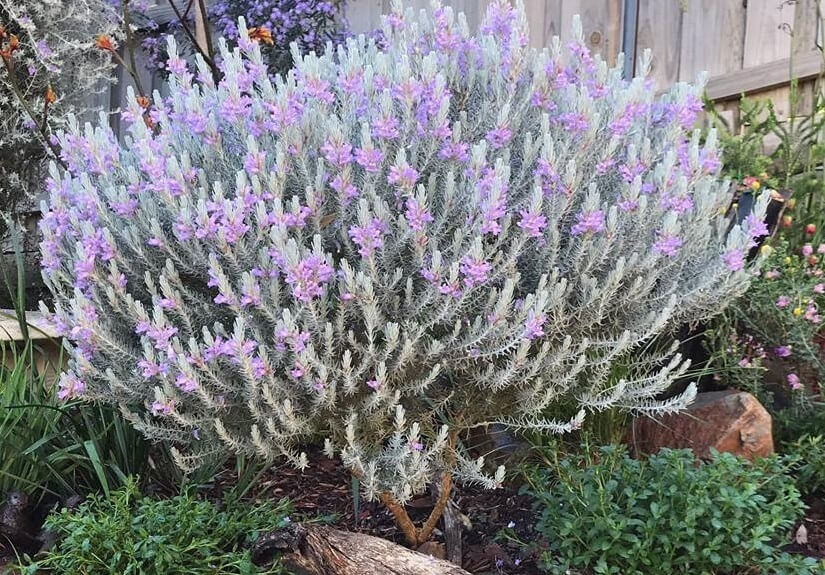
Source: davesgarden.com
Once established, the emu bush will be tolerant to drought and lightly resistant to frost. These hardy natives won’t require much upkeep once they have matured.
Another garden chore you won’t need to worry about with these shrubs is fertilising. Emu bush requires no fertiliser. Here are our top care tips for eremophila.
Watering Tar Bush
These shrubs are excellent water-savers. They will need more water after planting to help the roots establish themselves but thereafter, the plant will not need regular water.
Infrequent waterings that are generous should be ideal for the plant. Frequent, shallow watering is not healthy for these shrubs.
Pruning Eremophila
Emu bush will respond well to light pruning after the flowering season. Try to avoid cutting back the hardwood and just prune the softwood and foliage as needed.
Mulching Eremophila
Mulching is a practice that is also beneficial as it will maintain water near the roots where it needs to be. Many gardeners have a tendency to use organic mulches and these can be beneficial as they do break down and provide nutrients to the soil.
I have a preference for inorganic mulches though as they don’t absorb rainfall and allow water to run off and into the soil below.
Lets face it, organic mulches are great for keeping water in but if you live in a low rainfall area you must accept that quite a bit of the precious rainfall will be absorbed by the organic mulch and it will only be the excess rainfall that will eventually make its way to the soil below.
As I said organic mulches are great for keeping water in but next time you get some light rain (say 5mm) go and check just how much of that rainwater actually made its way to the soil below.
Therefore the thickness of your organic should reflect your rainfall and watering habits. I use 20mm stones as mulch, as the rain just runs straight off them and into the soil below plus they look great as well.
Frost Care
Most eremophilas will withstand some frost as most grow naturally in open areas that do experience freezing conditions over winter. If you live in an area that gets regular heavy frost though you may have to protect your eremophila as there aren’t many varieties that will stand up to these conditions.
If you do live in a frost prone area then select your plants wisely as not all varieties do withstand frost.
Common Emu Bush Pests & Diseases
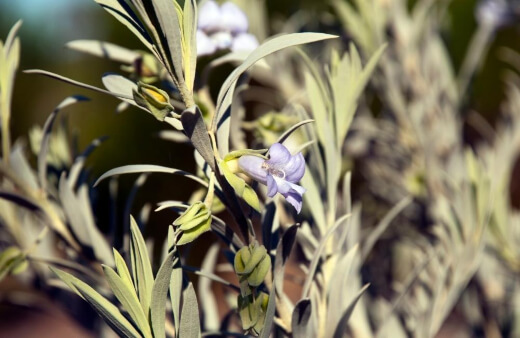
There is little information available for pests or diseases that these shrubs are susceptible to. However, like with most garden plants, there can be smaller issues of bug infestation or fungal attacks.
Most infestations can be treated with neem oil or a similar horticultural spray. Should you notice that the plant is developing fungal spores and spots, this could indicate that the soil is overwatered and that the roots are sitting in too much moisture.
Cut back on watering and allow the soil to dry out more frequently before your next watering.
Interested in growing more shrubs to your garden? Consider growing hebes which are super easy to maintain.
Emu Bush Frequently Asked Questions
Does eremophila have invasive roots?
In most states, the roots are not considered very invasive. However, in parts of the eastern states of Australia, some species of Eremophila are considered invasive in pastoral areas.
Is emu bush fast growing?
Yes, emu bush shrubs are considered fast-growing in most regions of Australia.
Can you grow emu bush from cuttings?
Gardeners love these hardy native shrubs as they can easily be grown from cuttings, meaning you can reliably build your collection throughout your garden as needed.
How do you grow eremophila?
Most species will thrive in an open sunny position with good air movement. Be sure to also plant in soil with excellent drainage.
Are emu bushes poisonous?
While these shrubs are not considered toxic to cats and dogs, they should not be eaten by people.
How often do you water an emu bush?
As these shrubs are sensitive to overwatering, you should allow the soil to dry out between waterings. Generally, you should water deeply but infrequently about once a week in summer, twice per month in spring and autumn, and once a month in winter.
Can you grow eremophila in pots?
Most members of this genus can be grown well in pots and other containers.
Is emu bush frost tolerant?
These ornamental shrubs are frost and drought-tolerant once established. They do however dislike excess humidity.
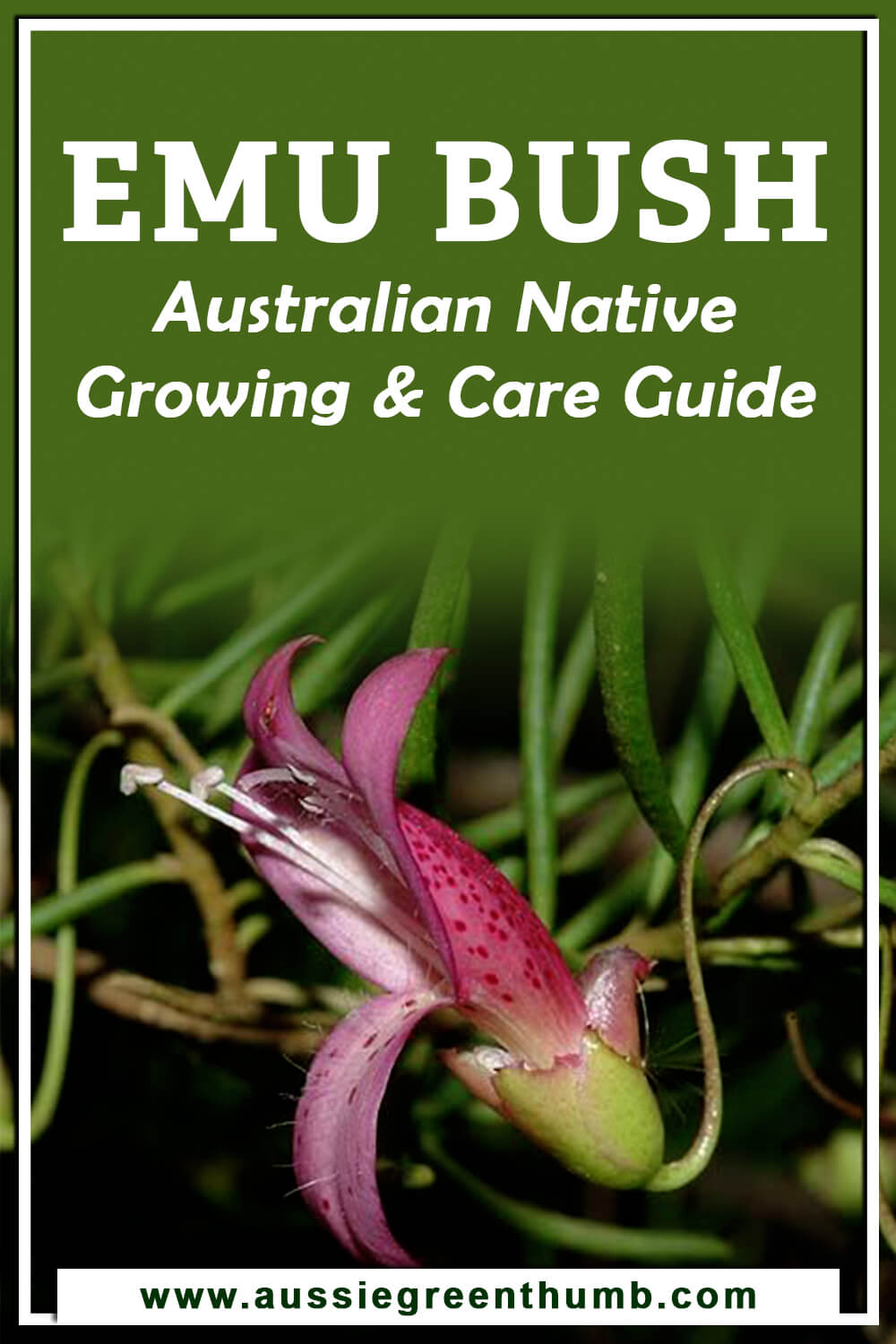
Wrapping Up Our Eremophila Guide
The perfect pick for growers who are looking for plants that can thrive in drier gardens, Eremophila is a must-have medium native shrub that will attract natural beauty to any space. Being extremely easy to maintain and care for, these shrubs can be used in wilder gardens and look fantastic planted alongside other Australian natives.
With a beautiful contrast of silvery-green tapered foliage shouldering delicate red tubular flowers, emu bush is a great option for a low-maintenance, ornamental garden plant.
Published on January 5, 2023 by Nathan Schwartz
Last Updated on August 26, 2025




